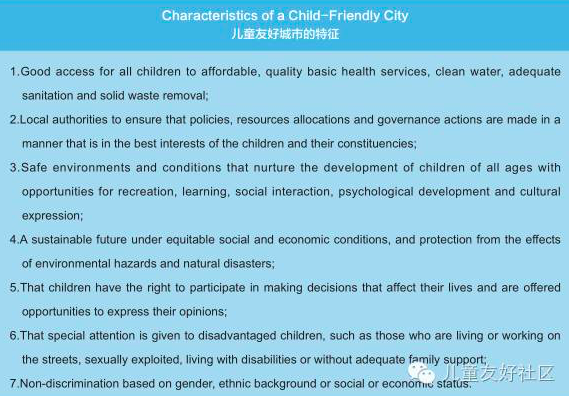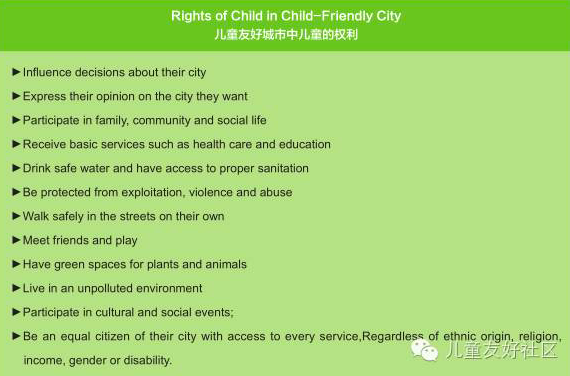
Child-friendly is a global consensu
Similar to the children ’s problems encountered in China ’s urbanization process, other countries around the world are also experiencing how to solve children ’s problems, exploring what is most beneficial to children, what is most important to their lives, and How to protect them from harm, how to exercise their rights as they grow up, and take more responsibility in the future. Child-friendly has become a global consensus.
Since the establishment of the United Nations, children's happiness and rights have been one of her main concerns. December 11, 1946 was established by UNICEF to meet the urgent needs of children after World War II. 1948, the Universal Declaration of Human Rights adopted by the UN General Assembly recognizes that children must receive special care and assistance. 1953, UNICEF became a permanent member of the United Nations system dedicated to the realization of the rights of mothers, children and children to survival, development, protection and participation in countries around the world. November 20, 1959 United Nations issued the Declaration of the Rights of the Child, but since the Declaration of the Rights of the Child does not have the effect of treaty law, treaty law guarantees to children's rights have become increasingly necessary. In the 1978 United Nations At the Commission on Human Rights, Professor Adam Lopatha of Poland initiated the drafting of the Convention on the Rights of the Child. 1979, the UN Commission on Human Rights begins work on a convention on the rights of the child. During the 10 years from 1979 to 1989, the Commission on Human Rights has studied the draft convention in detail, and after several textual amendments, 1989 marks the 30th anniversary of the publication of the Declaration on the Rights of the Child and the 10th anniversary of the establishment of the International Year of the Child. , Completed the drafting of the convention as scheduled and submitted it to the UN General Assembly through the Economic and Social Council. November 20, 1989, Resolution 44 of the 44th Session of the United Nations General Assembly unanimously adopted the Convention on the Rights of the Child and opened it to States for signature, ratification and ratification. September 2, 1990, the Convention on the Rights of the Child entered into force in accordance with article 49 of its text. To date, 193 countries around the world have become parties to the Convention on the Rights of the Child, becoming one of the most widely accepted conventions in the world.
The Convention on the Rights of the Child has 54 articles that define dozens of rights that all children around the world should enjoy, including the most basic right to survival, full development, protection and full participation in family, cultural and social life . The Convention on the Rights of the Child also establishes four basic principles: non-discrimination, maximizing the interests of children, the right to survival and development, and respect for children.
Based on the further protection and expansion of children's rights, the United Nations launched the "Child-Friendly Cities Initiative." Mr. Mylock, UNICEF's Representative Office in China, said: "There are several criteria for a 'child-friendly city'. In terms of image, whether children can walk safely on the roads themselves and whether children's rights are given priority in urban development . The key to a child-friendly city is a local good governance system that is committed to the full realization of children's rights. The core substance is the children's rights movement, which is based on the implementation of children's rights and extensive participation in urban local governance systems. "
"Child-Friendly Cities" is a global movement that was gradually developed on the basis of the "Mayor as Child Guardian" movement in the 1990s. It was formally proposed in 1992. 1996, the United Nations Habitat Conference stated that the well-being of children is the ultimate indicator of healthy living, a democratic society and good governance. May 2002, UN Secretary-General Kofi Annan called on the international community to work together to build a world fit for children at the first plenary session of the UN General Assembly on Children, expressly asking all member states to commit to developing communities that are beneficial to children And cities, and involve mayors and local governments as key partners in achieving this new goal for children.
In the description of the UN document, the characteristics of a child-friendly city should be:
1. High-quality basic health services available to all children, clean water, and a clean and hygienic environment;
2. Local authorities ensure that policies, resource allocation and governance actions are in the best interests of children and their voters;
3. Improve the safety environment for children of different ages so that they have more opportunities for entertainment, learning, social interaction, psychological development and cultural expression;
4. Sustainable development under fair social and economic conditions, protecting children from environmental hazards and natural disasters;
5. Children have the right to participate in decisions that affect their lives and to provide opportunities to express their views;
6. Pay particular attention to vulnerable children, such as those living or working on the streets, sexually exploited, disabled or lacking family support;
7. Don't discriminate on the basis of gender, race, social status or economic status.
Nine basic elements for building a child-friendly city include: Child participation in decision-making; a child-friendly legal framework; a child rights strategy covering the entire city; a child authority or coordination mechanism; impact evaluation and assessment of children; Special budgets; regular reports on the status of urban children; promotion of children's rights; independent child advocates.



To date, many cities and governments
around the world have joined the initiative to achieve "child-friendly
cities," and more than 400 cities have been certified by the United
Nations as "child-friendly cities."

In the United States, the city of Buddhism has created a “learning landscape” within the city—an urban-scale child-friendly outdoor play space environment. Each “learning landscape” includes community entrances, shades, public gathering areas, and nature. Wild parks, outdoor art, multi-purpose venues, safe play facilities that can participate, innovative elements, etc., provide children with a variety of play spaces and places for schooling that are in contact with nature.
The Government of London in the United Kingdom has
established the Office of the Child Rights Commissioner (Representative) and
the Children's Advisory Board. In 1998, the Hertfordshire County Council
promoted the “walking bus” program, which was first implemented at the
Wheatfield Middle School in St. Albans, UK, and is still widely used today. The
“walking bus” route is set on the primary consideration of safety, listening to
and respecting children ’s travel habits, including from school to community
fitness centers, community libraries, residential community entrances, park
activities and game venues, and natural mud for the route. Stones, wood,
plants, flowing water, children can observe small ants, small earthworms. This
route becomes a community roaming route, which can meet the needs of children
to play safely anytime, anywhere.
The Office of Children's Affairs was established in
Munich, Germany; Essen adopted the Project Action Plan to incorporate funds
into the municipal system and budget. Germany Playgrounds in foreign
communities provide children with exposure to nature and happy and adventurous
urban spaces. Legislation on children's rights and interests has shown the
distinctive features of a complete system and norms. The German Youth Affairs
Agency has strengthened supervision of so-called risky families. If there is a
solid clue that the child has been harmed, the Youth Affairs Agency needs to
conduct regular home visits. Doctors and psychologists can report to the
authorities without being bound by a "duty to keep secrets" after
they have grasped the major clues that a child has been abused.
Russia has a large network of non-governmental child rights
inspectors who have the right to ask questions about children, so they must
have all the skills and tools to protect their rights in order to protect every
child and their family. The Russian capital, Moscow, also has a child rights
inspector and street children program to protect children's rights. Child
protectors are those who provide all-round help to children. They are both
lawyers, psychologists, and social workers.
The Philippines has been running child-friendly cities since the
1990s
Table of Contents In recent years, the Philippines Ministry of Education has vigorously promoted basic health care programs.
Program (EHCP) to enable elementary school students to develop hygienic habits of washing their hands with soap and brushing their teeth with fluoride, and to carry out parasite removal activities in kindergartens and elementary schools. It is implemented in all 97 public primary schools in Guimaras Province. This activity not only brings fun to children, prevents bacterial infections and the spread of disease, but also encourages them to develop good personal hygiene habits that will benefit them for life.
In South Africa, “Safe and caring child-friendly schools”
Supported by UNICEF and non-governmental organizations, it is promoted by the South African Ministry of Education. Child-friendly schools are designed to help disadvantaged children increase their learning opportunities, improve their memory, complete their studies, and achieve academic success by improving life skills, community participation, and health and safety.
In both developed and developing countries, child-friendly has become a global consensus, and urban and rural communities are working hard to explore the best arrangements for children. As UNICEF Executive Director Anthony Lake said, "Urbanization is an inevitable part of our lives, and we must increase our investment and focus on providing services to the children in need."